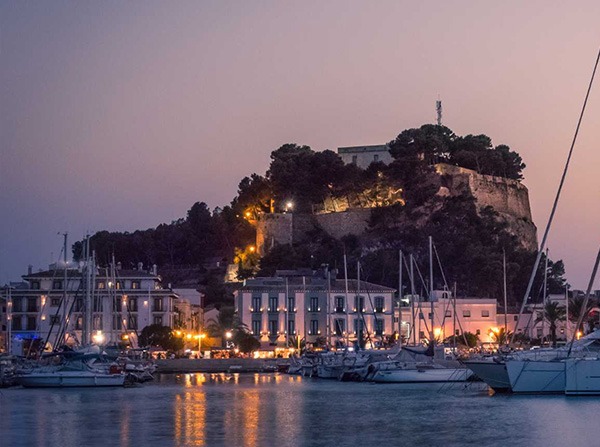
Why Denia?
Denia is located at 38°50′ north and 0°6’17 east. It has an area of 66.4 km2 and around 47,000 inhabitants. According to the WHO, it is one of the most liveable regions in the world, as the climate here is warm but humid enough, the location by the sea provides fresh air and with little industry there is also very little air pollution.
Denia is not unknown when it comes to living on the Spanish coast. Sometimes we hear a gasp of horror as soon as we even mention Denia, sometimes an ‘Oh how nice’. For us, Denia is a more or less logical decision. Valencia was the actual destination and the desire. But as we’ve already mentioned in previous articles, there was simply nothing pretty to discover there. We couldn’t find any favour in a city flat, nor in the villas 40 km+ north of Valencia.
Denia, our jumping off point to Ibiza
We’ve known Denia for a long time. Ever since we pulled into the harbour in Valencia from 2010 on, Denia has always been on our route when we were sailing to the Balearic Islands. We usually spent a few nights in Denia before setting off for Ibiza. We went to eat at the Republic in the harbour and took a walk through the pedestrian zone (or what we thought it was at the time).
In 2017, we sat at a table in Republic with a lonely elderly lady who tried to make her house appealing to us. She invited us to at least take a look at it. But we had other plans and were on our way home to Luxembourg. After an Atlantic crossing and a wonderful year in the Caribbean, we were really in the mood for family, friends, our house and the garden.
Who would have thought that Denia would become our home someday.
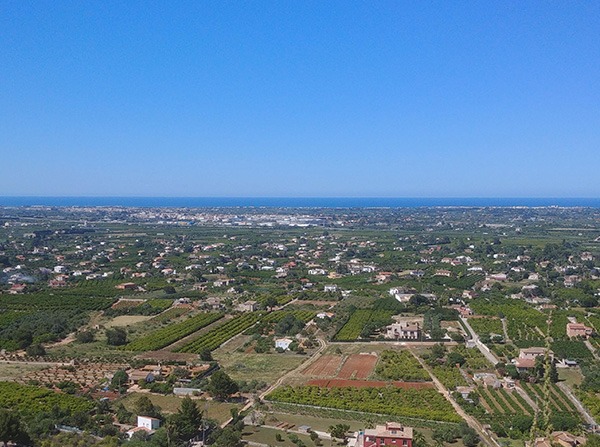
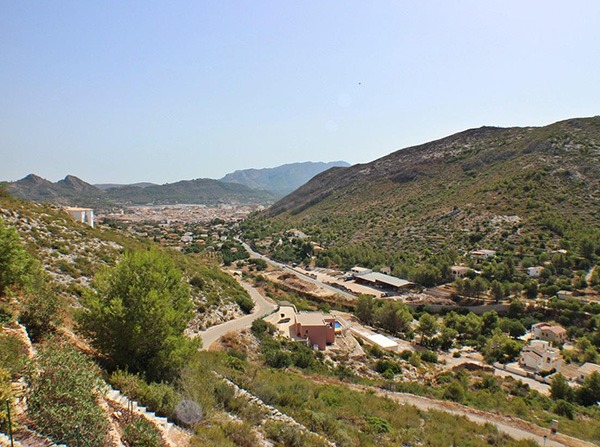
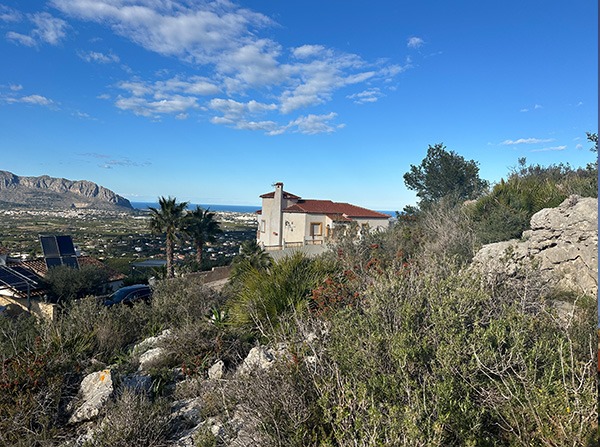
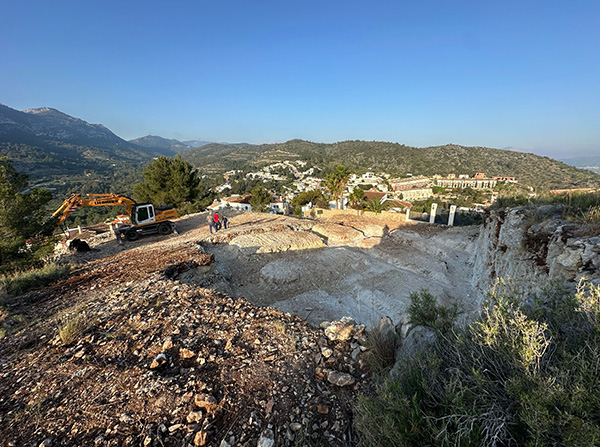
Top left: The view of the originally selected plot. Unfortunately too much slope for a garden. Top right. The view of the valley to the south.
Below: Our view. Towards the sea and the mountains.
When we were looking at plots and houses in Denia in 2023, we quickly realised that we didn’t want to go into the city. We want to look at it or be in the neighbourhood. Looking out is one of those things. The Montgo mountain would be an obvious choice. It’s beautiful, but also provides its inhabitants with plenty of shade. Especially in winter. So not Denia directly after all, because apart from the desire to live there, you also need a suitable and affordable house or plot of land. We looked at 6 plots and 4 houses in Denia and the surrounding area that were on our shortlist and finally decided in favour of Monte Solana.
Here is all the tourist material I could find on Mont Solana:
- Distance to Dénia: approx. 10-15 minutes by car
- Airports: Alicante (approx. 100 km), Valencia (approx. 110 km)
- Motorway connections: Easy access via the A-7 motorway
Monte Solana is a range of hills near Pedreguer. It is known both for its scenic beauty and for its housing estates. From almost anywhere you can enjoy a picturesque view of Mediterranean vegetation, including pine forests and olive groves. From the slopes, the view extends to the coast and the surrounding valley.
Denia and its impressive history
Now a little something about Denia. I’ll leave out the usual. Yes, the people are very friendly. In summer there is a lot of tourism in a part of the town that has been built up to the beach and most people here also speak English.
Denia’s history revolves around the castle and its harbour.
The origins of Dénia
Throughout history, archaeological finds have been discovered in various parts of Dénia that show that Iberians, Phoenicians and Greeks lived here, and later Visigoths and Moors.
200-400 AD – Roman Empire / Early Christianity
Denia, then known as Dianium, was part of the Roman Empire. The city developed into an important harbour town and towards the end of this period, Christianity spread to the region.
400-500 – Visigoths
After the fall of the Western Roman Empire, the Visigoths took control of the Iberian Peninsula, including Denia. The city remained a regional centre, but with significantly less economic importance.
711 – Moorish conquest
With the Islamic expansion, Arab-Berber troops entered Spain via Gibraltar and quickly conquered Denia. The city became part of Al-Andalus and developed anew under Islamic rule.
1010-1076 – Taifa Denia (independent Muslim kingdom)
After the collapse of the Caliphate of Córdoba, the Taifa Kingdom of Denia emerged. It was an important naval power with a strong fleet and even had possessions in the Balearic Islands.
1076-1091 – Affiliation with the Taifa Saragossa
The more powerful Taifa kingdom of Zaragoza annexed Denia. Political independence was lost, but the Islamic culture and administration remained.
1091-1224 – Almoravids and Almohads
The Almoravids (a Berber dynasty from North Africa) took control first, followed later by the Almohads. Both ruled over large parts of Al-Andalus and introduced a stricter interpretation of Islam.
1224-1244 – Last Muslim control
After the fall of the Almohads, local Muslim rulers briefly took control of Denia. However, the city was militarily weakened and increasingly isolated.
1244 – Christian reconquest by Aragón
King James I of Aragón conquered Denia as part of the ‘Reconquista’. The Muslim population was partly expelled and partly forcibly converted, and Denia was repopulated and integrated into the Christian kingdom.
From 1244 – Crown of Aragón / later Spain
Denia became part of the Kingdom of Valencia under the Crown of Aragón. With the unification of Aragón and Castile, it later became part of the Spanish kingdom, but retained its strategic importance as a harbour city.
World War I (1914-1918)
Spain remained neutral in the First World War. The war therefore had no direct military impact on Denia. The city was more affected by the economic consequences – such as trade difficulties and supply shortages.
World War II (1939-1945)
Spain also remained officially neutral during the Second World War under Franco. However, Denia, like many Spanish coastal towns, was heavily affected by the Spanish Civil War (1936-1939). After the civil war, Denia suffered economic hardship, political repression and isolation – but no direct military action during the Second World War.
A not very nice chapter
When we were sitting in a café with friends in spring 25, we heard about a Nazi enclave in Denia for the first time. No-one knows anything for sure and my sources are pretty tight-lipped. As there was plenty of room for Nazis in Franco’s Spain after World War II, Denia developed into a place of refuge.
I won’t mention the names of the Nazi criminals. But there were some not entirely unknown ones. Most of them either disappeared to South America or were found. When we go to look at the Vila El Tosalet, we see this picture.
The author Clara Sánchez described these conditions in “Lo que esconde tu nombre” (Nadal Prize for Literature 2010).
The movie “The Deputy” also tells the story of a murder case and the investigation in a German colony in Dénia that celebrates its deep brown past.
As the current mayor belongs to a centre-left party, we can hope that the brown mongrels don’t feel very comfortable here.
